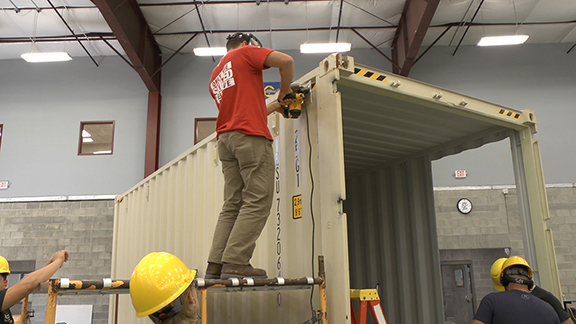
At a glance
 The purpose of the project, Jones said, is to determine if shipping containers can be repurposed into high-efficiency housing or office units, and also to provide students with a new form of applied learning.
The purpose of the project, Jones said, is to determine if shipping containers can be repurposed into high-efficiency housing or office units, and also to provide students with a new form of applied learning.

A new hands-on project at Alfred State College’s Wellsville campus has students really thinking outside the container.
This semester, students in various majors began working on several shipping containers as part of a “reuse/repurpose/recycle” initiative that incorporates sustainable and green-building practices, according to Jack Jones, chair of the Building Trades Department. The purpose of the project, Jones said, is to determine if shipping containers can be repurposed into high-efficiency housing or office units, and also to provide students with a new form of applied learning.
One of the main goals of this project is to create a zero-energy facility, which means it produces at least as much energy as it consumes.
“This project aligns with the governor’s new energy initiatives, which aim to drive New York’s energy consumption to renewable sources,” explained Jones. “The home will be outfitted with a powerful photovoltaic system and a solar water heater.”
High-efficiency fixtures and appliances, Jones said, will be used throughout.
“We are designing the home with a battery bank for off-grid operation,” he said. “However, we will also include a utility connection for selling excess power generation and for a back-up power supply.”

shipping containers into either housing or office units.
With the project being so new and so different from what has been done before, Jones noted, “We’re just trying to learn what works, what doesn’t work, what we can do in the future, and what really doesn’t make sense to do. It’s really a research project on our part to determine whether this is a viable option for housing or not, and whether it fits into our educational program.”
The project involves the talents of students in several different majors, including building trades: building construction; heating, ventilation, and air conditioning; and electrical construction and maintenance electrician. Supporters so far include the State University of New York (SUNY), which is funding the project; SUNY Chancellor Kristina M. Johnson; the Educational Foundation of Alfred, Inc., which has postponed other construction projects to accommodate this one; and Mach Architecture, which has assisted with the design and engineering of the project.
“I am so proud of the students and faculty at Alfred State for conceiving a creative project that combines applied learning and sustainability,” said SUNY Chancellor Johnson. “It’s more proof that, each and every day, SUNY is helping lead the way toward a more sustainable, energy-efficient world, while also providing the types of hands-on learning experiences that lead to higher-paying jobs for our students.”
Another big supporter is Alfred State President Dr. Skip Sullivan, who said, “This project offers Alfred State students an incredible and unique opportunity for hands-on learning. We are grateful to SUNY, Chancellor Johnson, the Educational Foundation, Mach Architecture, and so many others who have shown their support and enthusiasm for this project. We can’t wait to see the finished product!”
One of the most appealing aspects of the project, Jones said, is its unconventional nature. While students are still gaining traditional real-world skills working on houses for the Wellsville community, this project gives them a chance to broaden their horizons.
“They get to use tools they wouldn’t normally use, they get to work with materials they wouldn’t normally use,” Jones said. “They’ll be doing a little more welding here than what we usually have in our program, a lot more metal-cutting, and just experiencing a different way that systems go together. This job will be more commercial application, so a lot more metal work, steel studs, that sort of thing. It’s a really good supplement to what we already do.”
Students are understandably very excited about the project. Nathan Hayes, a building trades: building construction major from Bath, said, “My favorite part is getting an idea of how you can take everyday items, repurpose them, upcycle them, and turn them into something very useful that’s going to leave a lasting impression on the campus. It’s something you can look back on and be really proud of your craftsmanship.”
Courtney DeRusha, a masonry student from Corning, said, “One of the really exciting things about this project is that it’s been developed by a team of experts, engineers, and architects, but there’s a lot of innovation, there’s a lot of experimentation. We don’t know exactly how we’re going to tackle every problem, and to have all of these brains talking about that together with the help of our really knowledgeable instructors is exciting.”
The containers are presently located in the 35,000-square-foot Workforce Development Center, which serves as the home of the building trades: building construction program. Currently, the college has four shipping containers for students to work on, three of which are 20 feet long and one that is 40 feet long.
“Altogether, with the enclosed space in the middle, we’ll have about a 1,200-square-foot building when we’re done,” Jones said. “This is really a larger and more complex home than you would typically consider for containers. We hope to learn lessons that can be applied to temporary housing, disaster relief shelters, and housing in developing countries.”
The end goal for this project, Jones said, is to convert the containers into a new demonstration home and welcome center on the Alfred campus. The project should take one academic year to complete.
“I think it’s a really cool project. It’s something that’s out of the ordinary,” said Jones, who added, “It’s a really good option for us to really just stretch the students and make them think about why systems have to work the way they do.”
